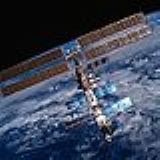
Night Glider mode
Encyclopedia
Night Glider mode is one of the procedures for orienting the solar arrays on the International Space Station
.
Normally the photovoltaic
solar arrays of the space station track the sun. However, one of the main causes of orbital decay
on the space station is that the area of the solar arrays, brushing against the thin residual atmosphere at orbital altitude, results in a small amount of aerodynamic drag. The drag can be lowered by orienting the solar arrays in "sun slicer" mode, where they fly edge-on to the orbital direction, rather than tracking the sun, however, this orientation reduces the power produced. The "night glider" mode is a hybrid orientation, where the solar arrays track the sun during the period when the space station is illuminated, but are oriented edge-on to the sun when it is in the Earth's shadow. This reduces the average drag on the station's solar arrays by about 30 percent, with no reduction in power.
 Use of night-glider mode had been proposed at NASA Lewis early in the space station's history, but was only implemented in 2003, after the Space Shuttle Columbia disaster
Use of night-glider mode had been proposed at NASA Lewis early in the space station's history, but was only implemented in 2003, after the Space Shuttle Columbia disaster
, when the ability of the space shuttle
to bring propellant to the station for orbital maintenance was removed while the space shuttle program went through a period of redesign. The implementation of drag-reducing flight modes of the space station resulted in saving about 1,000 kg of orbital-maintenance propellant per year.
A different operational mode, sun slicer drag-reduction, is also sometimes used; in sun slicer mode, the arrays are oriented edge-on to the direction of travel for the full orbit. In this mode, the drag is minimized, however, the power output is reduced from the full power available. Operationally, it is sometimes desirable to orient the solar arrays to produce the opposite effect, and maximize the drag on the arrays. This may be done, for example, to reduce the space station orbital altitude in order to reduce the amount of fuel required for the shuttle to reach the space station. Choosing which solar array orientation mode is used is a function of ISS operations ("mission control").
International Space Station
The International Space Station is a habitable, artificial satellite in low Earth orbit. The ISS follows the Salyut, Almaz, Cosmos, Skylab, and Mir space stations, as the 11th space station launched, not including the Genesis I and II prototypes...
.
Normally the photovoltaic
Photovoltaics
Photovoltaics is a method of generating electrical power by converting solar radiation into direct current electricity using semiconductors that exhibit the photovoltaic effect. Photovoltaic power generation employs solar panels composed of a number of solar cells containing a photovoltaic material...
solar arrays of the space station track the sun. However, one of the main causes of orbital decay
Orbital decay
Orbital decay is the process of prolonged reduction in the altitude of a satellite's orbit.This can be due to drag produced by an atmosphere due to frequent collisions between the satellite and surrounding air molecules. The drag experienced by the object is larger in the case of increased solar...
on the space station is that the area of the solar arrays, brushing against the thin residual atmosphere at orbital altitude, results in a small amount of aerodynamic drag. The drag can be lowered by orienting the solar arrays in "sun slicer" mode, where they fly edge-on to the orbital direction, rather than tracking the sun, however, this orientation reduces the power produced. The "night glider" mode is a hybrid orientation, where the solar arrays track the sun during the period when the space station is illuminated, but are oriented edge-on to the sun when it is in the Earth's shadow. This reduces the average drag on the station's solar arrays by about 30 percent, with no reduction in power.

Space Shuttle Columbia disaster
The Space Shuttle Columbia disaster occurred on February 1, 2003, when shortly before it was scheduled to conclude its 28th mission, STS-107, the Space Shuttle Columbia disintegrated over Texas and Louisiana during re-entry into the Earth's atmosphere, resulting in the death of all seven crew members...
, when the ability of the space shuttle
Space Shuttle
The Space Shuttle was a manned orbital rocket and spacecraft system operated by NASA on 135 missions from 1981 to 2011. The system combined rocket launch, orbital spacecraft, and re-entry spaceplane with modular add-ons...
to bring propellant to the station for orbital maintenance was removed while the space shuttle program went through a period of redesign. The implementation of drag-reducing flight modes of the space station resulted in saving about 1,000 kg of orbital-maintenance propellant per year.
A different operational mode, sun slicer drag-reduction, is also sometimes used; in sun slicer mode, the arrays are oriented edge-on to the direction of travel for the full orbit. In this mode, the drag is minimized, however, the power output is reduced from the full power available. Operationally, it is sometimes desirable to orient the solar arrays to produce the opposite effect, and maximize the drag on the arrays. This may be done, for example, to reduce the space station orbital altitude in order to reduce the amount of fuel required for the shuttle to reach the space station. Choosing which solar array orientation mode is used is a function of ISS operations ("mission control").
External links
- A tutorial on space station operation fundamentals: J. Bacon, Space Flight 101, (2006), pp. 81-92. See NASA Scientific and Technical Aerospace Report, V. 44, issue 21, p. 12 (2006).
- Overview of night-glider mode: NASA Glenn Research Center, "Change in Solar Array Orientation Successfully Reduced ISS Propellant Usage," Research and Technology 2006, NASA TM-2007-214479, pp. 118-119 (2007).
- International Space Station (ISS) power supply information at Aviation Spectator

